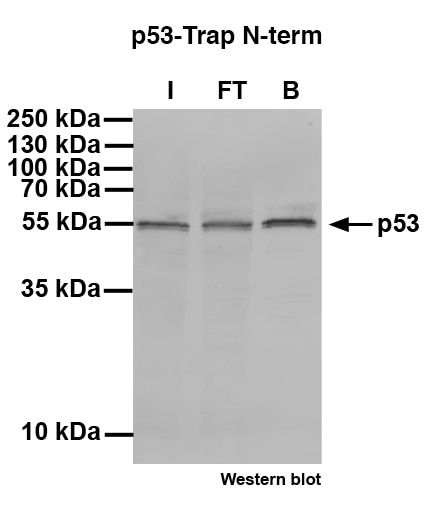Validation Data Gallery
Product Information
p53-N-term-Trap Agarose is an affinity reagent for IP of p53. It consists of a p53 Nanobody/ VHH coupled to agarose beads, and which binds to the N-terminus of p53.
| Description | Immunoprecipitation of p53 with p53-N-term-Trap Agarose.
• Pull down of human p53 isoforms alpha, beta and gamma with p53-Trap-N-term • Immunoprecipitation of the human p53 proteome with complementary p53-C-term- and p53-N-term-Traps, e.g. p53 isoforms and variants • No heavy & light antibody chains in your downstream application • Short incubation time (60 min at +4 °C) |
| Applications | IP, CoIP |
| Specificity/Target | p53 (isoforms: alpha, beta, and gamma); epitope 1-81 aa |
| Tested Reactivity | Human |
| Conjugate | Agarose beads; bead size: ~ 90 µm (cross-linked 4 % agarose beads) |
| Elution buffer | SDS sample buffer 0.2 M glycine pH 2.5 |
| Type | Nanobody |
| Class | Recombinant |
| Host | Alpaca |
| Compatibility with mass spectrometry | The p53-N-term-Trap is optimized for on-bead digestion. For the application note, please click here: On-bead digest protocol for mass spectrometry |
| RRID | AB_2631378 |
| Storage Buffer | 20% ethanol |
| Storage Condition | Upon receipt store at +4°C. Do not freeze! |
| Size | 25ul/reactions (eg:20rxns=500ul slurry) |
Publications
| Application | Title |
|---|---|
Cell Death Differ The ubiquitin ligase LIN41/TRIM71 targets p53 to antagonize cell death and differentiation pathways during stem cell differentiation. | |
PLoS Pathog Novel modulators of p53-signaling encoded by unknown genes of emerging viruses. | |
Cancers (Basel) AML-Related NPM Mutations Drive p53 Delocalization into the Cytoplasm with Possible Impact on p53-Dependent Stress Response. | |
J Virol The ORF45 protein of Kaposi Sarcoma-associated Herpesvirus (KSHV) is an inhibitor of p53 signaling during viral reactivation. | |
Sci Rep Hypoxia-inducible factor prolyl-4-hydroxylase-1 is a convergent point in the reciprocal negative regulation of NF-κB and p53 signaling pathways. |
Reviews
The reviews below have been submitted by verified Proteintech customers who received an incentive for providing their feedback.
FH Davood (Verified Customer) (03-17-2025) | I highly recommend. High specificity
|
FH Celine (Verified Customer) (10-26-2024) | The P53 N-terminal Trap beads worked well and were easy to use. Signal strength was good as tested through Western Blotting. Our lab had previously tried the C-terminal beads but the P53 N-terminal beads worked better in our experimental set up.
|
FH Liam (Verified Customer) (09-05-2024) | The P53 N-terminal Trap beads were easy to use, worked first time, and gave a strong signal after western blotting. I had previously used the GFP-Trap beads for other experiments and was glad to see that the P53 ones worked just as well. I also tried the P53 C-terminal beads which did work. They were not as strong in my experiment as the the N-terminal ones, but it was worth testing both types to see which was better for my specific experiment.
|

